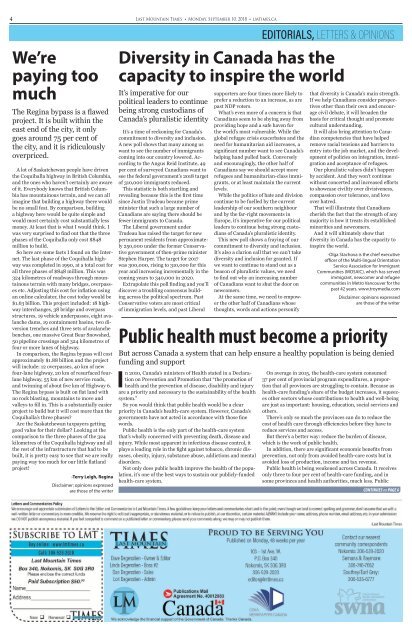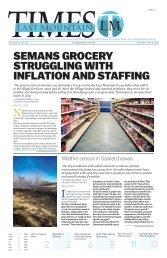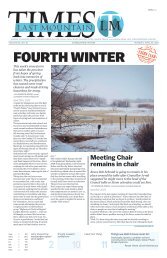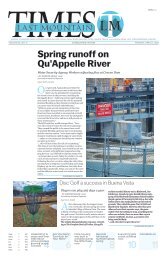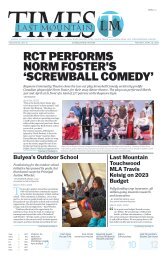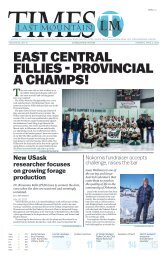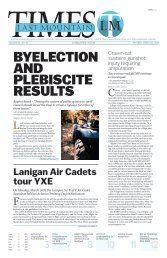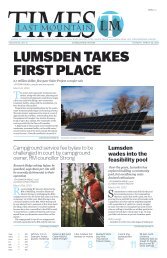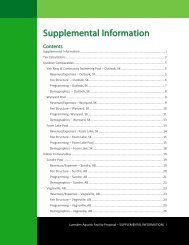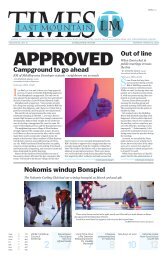LMT September 10 2018
Create successful ePaper yourself
Turn your PDF publications into a flip-book with our unique Google optimized e-Paper software.
4 Last Mountain Times • Monday, <strong>September</strong> <strong>10</strong>, <strong>2018</strong> • lmtimes.ca<br />
We’re<br />
paying too<br />
much<br />
The Regina bypass is a flawed<br />
project. It is built within the<br />
east end of the city, it only<br />
goes around 75 per cent of<br />
the city, and it is ridiculously<br />
overpriced.<br />
A lot of Saskatchewan people have driven<br />
the Coquihalla highway in British Columbia,<br />
and the ones who haven’t certainly are aware<br />
of it. Everybody knows that British Columbia<br />
has mountainous terrain, and we can all<br />
imagine that building a highway there would<br />
be no small feat. By comparison, building<br />
a highway here would be quite simple and<br />
would most certainly cost substantially less<br />
money. At least that is what I would think. I<br />
was very surprised to find out that the three<br />
phases of the Coquihalla only cost $848<br />
million to build.<br />
So here are some facts I found on the Internet.<br />
The last phase of the Coquihalla highway<br />
was completed in 1990, at a total cost for<br />
all three phases of $848 million. This was<br />
324 kilometres of roadways through mountainous<br />
terrain with many bridges, overpasses<br />
etc. Adjusting this cost for inflation using<br />
an online calculator, the cost today would be<br />
$1.63 billion. This project included: 18 highway<br />
interchanges, 38 bridge and overpass<br />
structures, 19 vehicle underpasses, eight avalanche<br />
dams, 19 containment basins, two diversion<br />
trenches and three sets of avalanche<br />
benches, one massive Great Bear Snowshed,<br />
50 pipeline crossings and 324 kilometres of<br />
four or more lanes of highway.<br />
In comparison, the Regina bypass will cost<br />
approximately $1.88 billion and the project<br />
will include: 12 overpasses, 40 km of new<br />
four-lane highway, 20 km of resurfaced fourlane<br />
highway, 55 km of new service roads,<br />
and twinning of about five km of Highway 6.<br />
The Regina bypass is built on flat land with<br />
no rock blasting, mountains to move and<br />
valleys to fill in. This is a substantially easier<br />
project to build but it will cost more than the<br />
Coquihalla’s three phases?<br />
Are the Saskatchewan taxpayers getting<br />
good value for their dollar? Looking at the<br />
comparison to the three phases of the 324<br />
kilometres of the Coquihalla highway and all<br />
the rest of the infrastructure that had to be<br />
built, it is pretty easy to see that we are really<br />
paying way too much for our little flatland<br />
project!<br />
-Terry Leigh, Regina<br />
Disclaimer: opinions expressed<br />
are those of the writer<br />
Diversity in Canada has the<br />
capacity to inspire the world<br />
It’s imperative for our<br />
political leaders to continue<br />
being strong custodians of<br />
Canada’s pluralistic identity<br />
It’s a time of reckoning for Canada’s<br />
commitment to diversity and inclusion.<br />
A new poll shows that many among us<br />
want to see the number of immigrants<br />
coming into our country lowered. According<br />
to the Angus Reid Institute, 49<br />
per cent of surveyed Canadians want to<br />
see the federal government’s <strong>2018</strong> target<br />
of 3<strong>10</strong>,000 immigrants reduced.<br />
This statistic is both startling and<br />
revealing because this is the first time<br />
since Justin Trudeau became prime<br />
minister that such a large number of<br />
Canadians are saying there should be<br />
fewer immigrants to Canada.<br />
The Liberal government under<br />
Trudeau has raised the target for new<br />
permanent residents from approximately<br />
250,000 under the former Conservative<br />
government of then-prime minister<br />
Stephen Harper. The target for 2017<br />
was 300,000, rising to 3<strong>10</strong>,000 for this<br />
year and increasing incrementally in the<br />
coming years to 340,000 in 2020.<br />
Extrapolate this poll finding and you’ll<br />
discover a troubling consensus building<br />
across the political spectrum. Past<br />
Conservative voters are most critical<br />
of immigration levels, and past Liberal<br />
Public health must become a priority<br />
But across Canada a system that can help ensure a healthy population is being denied<br />
funding and support<br />
In 20<strong>10</strong>, Canada’s ministers of Health stated in a Declaration<br />
on Prevention and Promotion that “the promotion of<br />
health and the prevention of disease, disability and injury<br />
are a priority and necessary to the sustainability of the health<br />
system.”<br />
So you would think that public health would be a clear<br />
priority in Canada’s health-care system. However, Canada’s<br />
governments have not acted in accordance with those fine<br />
words.<br />
Public health is the only part of the health-care system<br />
that’s wholly concerned with preventing death, disease and<br />
injury. While most apparent in infectious disease control, it<br />
plays a leading role in the fight against tobacco, chronic diseases,<br />
obesity, injury, substance abuse, addictions and mental<br />
disorders.<br />
Not only does public health improve the health of the population,<br />
it’s one of the best ways to sustain our publicly-funded<br />
health-care system.<br />
supporters are four times more likely to<br />
prefer a reduction to an increase, as are<br />
past NDP voters.<br />
What’s even more of a concern is that<br />
Canadians seem to be shying away from<br />
providing hope and a safe haven for<br />
the world’s most vulnerable. While the<br />
global refugee crisis exacerbates and the<br />
need for humanitarian aid increases, a<br />
significant number want to see Canada’s<br />
helping hand pulled back. Conversely<br />
and encouragingly, the other half of<br />
Canadians say we should accept more<br />
refugees and humanitarian-class immigrants,<br />
or at least maintain the current<br />
levels.<br />
While the politics of hate and division<br />
continue to be fuelled by the current<br />
leadership of our southern neighbour<br />
and by the far-right movements in<br />
Europe, it’s imperative for our political<br />
leaders to continue being strong custodians<br />
of Canada’s pluralistic identity.<br />
This new poll shows a fraying of our<br />
commitment to diversity and inclusion.<br />
It’s also a clarion call that we can’t take<br />
diversity and inclusion for granted. If<br />
we want to continue to stand out as a<br />
beacon of pluralistic values, we need<br />
to find out why an increasing number<br />
of Canadians want to shut the door on<br />
newcomers.<br />
At the same time, we need to empower<br />
the other half of Canadians whose<br />
thoughts, words and actions personify<br />
EDITORIALS, LETTERS & OPINIONS<br />
that diversity is Canada’s main strength.<br />
If we help Canadians consider perspectives<br />
other than their own and encourage<br />
civil debate, it will broaden the<br />
basis for critical thought and promote<br />
cultural understanding.<br />
It will also bring attention to Canadian<br />
competencies that have helped<br />
remove racial tensions and barriers to<br />
entry into the job market, and the development<br />
of policies on integration, immigration<br />
and acceptance of refugees.<br />
Our pluralistic values didn’t happen<br />
by accident. And they won’t continue<br />
without concerted and increased efforts<br />
to showcase civility over divisiveness,<br />
compassion over tolerance, and love<br />
over hatred.<br />
That will illustrate that Canadians<br />
cherish the fact that the strength of any<br />
majority is how it treats its established<br />
minorities and newcomers.<br />
And it will ultimately show that<br />
diversity in Canada has the capacity to<br />
inspire the world.<br />
-Olga Stachova is the chief executive<br />
officer of the Multi-lingual Orientation<br />
Service Association for Immigrant<br />
Communities (MOSAIC), which has served<br />
immigrant, newcomer and refugee<br />
communities in Metro Vancouver for the<br />
past 42 years. www.troymedia.com<br />
Disclaimer: opinions expressed<br />
are those of the writer<br />
On average in 2015, the health-care system consumed<br />
37 per cent of provincial program expenditures, a proportion<br />
that all provinces are struggling to contain. Because as<br />
health-care funding’s share of the budget increases, it squeezes<br />
other sectors whose contributions to health and well-being<br />
are just as important: housing, education, social services and<br />
others.<br />
There’s only so much the provinces can do to reduce the<br />
cost of health care through efficiencies before they have to<br />
reduce services and access.<br />
But there’s a better way: reduce the burden of disease,<br />
which is the work of public health.<br />
In addition, there are significant economic benefits from<br />
prevention, not only from avoided health-care costs but in<br />
avoided loss of production, income and tax revenue.<br />
Public health is being weakened across Canada. It receives<br />
only three to four per cent of health-care funding, and in<br />
some provinces and health authorities, much less. Public<br />
CONTINUES on PAGE 6


